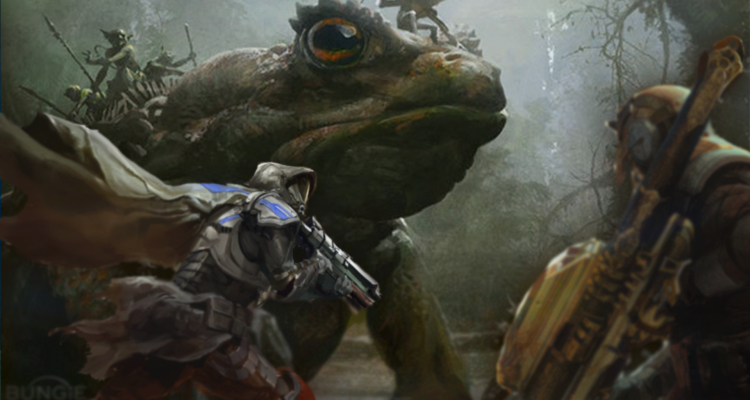Destiny is launching this Tuesday, September 9th. With it’s PSN-breaking beta, and it’s live action trailer during the first NFL game of the season, it is well set up to be a successful launch. Something you may not know, though, is that the origins of Bungie’s next big franchise began in a fantasy world.
After making five widely successful Halo titles in the span of 10 years, you can imagine the pressure on Bungie to create a new universe that would have a similar impact on the gaming community. Epic vistas, intense action, and memorable characters have always been the ingredients to their success. “Let’s build a world where we can tell any great story we want… A place [that] millions of people will want to visit again and again for the next 10 years -and more.” -Christopher Barnett, Art Director
When contemplating the type of game to spend the next decade developing, Bungie chose to explore a different design approach. “We wanted to build a big world that encourages you to explore off that path.” (referring to what they call the “Halo pipeline” style of gameplay).
Destiny’s first steps in the conceptual phase were set in high fantasy; castles, myths, monsters and legends were all imagined in the early pre-production phase. “But, we couldn’t shake the lure of sci-fi,” Christopher Barnett said, “Ancient ruins are cool, but so are derelict spaceships. Both are powerful mysteries, begging you to explore them.” Bungie’s answer to this conundrum was, conveniently, “Let’s do both!”
“Sky scrapers have become dungeons, their lower floors buried in snow.” -Joe Staten
 Thusly, Destiny’s unique “mythic sci-fi” genre was born. From what we have seen and played so far, though, their love for fantasy themes and motifs went a bit deeper than pre-production ambition.
Thusly, Destiny’s unique “mythic sci-fi” genre was born. From what we have seen and played so far, though, their love for fantasy themes and motifs went a bit deeper than pre-production ambition.
“When we were exploring the fantasy genre, this is how we imagined the center of Destiny’s world. A cheerful, beautiful city. A place that welcomed you home at the end of your adventures, a place that was surrounded by darkness and danger.” -Joseph Staten, Writer & Design Creator.
This fantasy concept inspired what became Destiny’s hyper-futuristic Last Safe City on Earth. A place therein, called the Tower, could easily mirror a common town in Dungeons & Dragons. The Tower is reminiscent of a town courtyard; with long flags waving in the wind, street vendors selling weapons and armor, a postman (or robot) waving you down and transmitting important messages. Within the Tower lies the Hall of Guardians -the information hub. With it’s long table, covered in sprawling maps and books, and surrounded by the most elite heroes planning their next quest, I think it’s safe to say we’ve found the iconic D&D tavern setting!
“…Your personal ship, your metaphorical horse…” -Joe Staten
 Destiny‘s story, or at least what we know of it so far, is well aligned with the fantasy genre. A god-like protector, known as the Traveler, visited humanity and bestowed upon them “the light”, which ushered in a golden age of technology, and allowed humans to travel to neighboring planets. An ancient and insidious foe, known as the Darkness, followed the Traveler to Earth. This force brought the ascended humans to their knees and nearly wiped them out, but the Traveler was able to fend off the Darkness, and still watches over the Last Safe City on Earth.
Destiny‘s story, or at least what we know of it so far, is well aligned with the fantasy genre. A god-like protector, known as the Traveler, visited humanity and bestowed upon them “the light”, which ushered in a golden age of technology, and allowed humans to travel to neighboring planets. An ancient and insidious foe, known as the Darkness, followed the Traveler to Earth. This force brought the ascended humans to their knees and nearly wiped them out, but the Traveler was able to fend off the Darkness, and still watches over the Last Safe City on Earth.
Even the character classes are common archetypes found in fantasy RPGs: the Titan (Fighter/Paladin) is a front line tank, clad in ornate full plate. The Hunter (Rogue/Ranger) is lightly armored, quick and nimble, with mobility and speed being key attributes. Lastly, the Warlock (Wizard/Sorcerer) is a nearly unarmored artillery force.
We have even more examples of classic fantasy themes: Psions, Goblins, Minotaurs, Hydras, Ogres, Harpys, and most famously, Moon Wizards, can all be found (at least in name) in the universe of Destiny.
All of this is not to say that Destiny draws it’s design exclusively from fantasy. There are plenty of post-apocalyptic, and even western inspirations to be found, from artists like John Harris, Alan Lynch and John Berkely, among countless others. In the world of mainstream game development, unique recreations of ideas like these are quite welcome! If you want to check out the full, hour-long walk through of Bungie’s process, check out the 2013 GDC talk here.
What other genres could we smash together? Half-Life: the fantasy game? Perhaps, the Lord of the Rings, with sci-fi! Do you have any ideas for a cool genre mash-up? Let us know in the comments below.

